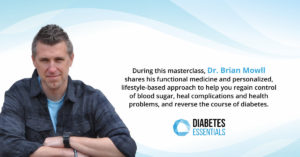I want to help you manage your type 2 diabetes naturally. Controls For Diabetes may collect a share of sales or compensation from the links on this page.
Diabetes Essentials Masterclass
 There’s a common saying in the diabetes community: diabetes won’t kill you, but it’s complications will. Please attend the Diabetes Essentials Masterclass: Encore Weekend – November 17 – 19, 2019.
There’s a common saying in the diabetes community: diabetes won’t kill you, but it’s complications will. Please attend the Diabetes Essentials Masterclass: Encore Weekend – November 17 – 19, 2019.
Why is diabetes so dangerous?
According to the American Diabetes Association, diabetes was the 7th leading cause of death in the United States in 2010, with over 69,000 death certificates listing it as the underlying cause of death.
Add to that the common complications, like cardiovascular disease, kidney disease and infection, and you can multiply that number by 10!
Yet despite these eye-opening statistics, I still see far too many people not taking diabetes seriously. They approach it as something that’s a nuisance rather than something that can and does cause major health complications. Morbidity and then mortality, if uncontrolled.
—>>That’s why I encourage you to join me at Dr. Brian Mowll’s free Diabetes Essentials Masterclass!
Diabetes is more dangerous than most people assume, and so it becomes easy for many people with diabetes to get lax in their efforts to manage the dysfunction. A 2012 GAPP2 (Global Attitude of Patients and Physicians 2) survey found that 22% of insulin-using diabetic patients missed a basal insulin dose during a 30-day period.
There are very real dangers diabetes poses if left unchecked or mismanaged, and one of my goals today is to motivate you into taking better care of yourself or helping a loved one manage the disease better.
Why is diabetes so dangerous? Because if not managed correctly, it can wreak havoc on just about every system and organ in the body. Let’s take a look at some of the biggest risks diabetic complications pose:
Diabetic Ketoacidosis
Diabetic Ketoacidosis is a very dangerous condition that can occur when patients neglect to take their insulin and have uncontrolled blood sugar. Since insulin is necessary to break down glucose as a source of energy, the body then turns to body fat as a fuel source.
While you may think that burning fat for fuel sounds like a great idea, it’s not in this case. This process of using fat and not glucose for fuel leads to an excessive and dangerous buildup of byproducts called “ketones” making the blood very acidic.
This is not the same thing as nutritional ketosis, which is the presence of a small to moderate amount of ketones in the blood that occurs during fasting or with strategic low carbohydrate diets. Nutritional ketosis is safe and used therapeutically for people who suffer from seizures and other health issues.
If left unchecked, however, diabetic ketoacidosis can lead to a diabetic coma and even death. This complication is increasing, with 80,000 hospitalizations reported in 1988 and 140,000 cases in 2009. Symptoms of the condition include difficulty breathing, acute abdominal pain, dehydration, weakness and vomiting.
Diabetic Retinopathy
 The retina is the innermost layer of the eye and it performs an incredibly important function. The retina receives light from our surroundings and converts that light into neural signals that are sent to the brain for recognition. Thanks to the retina we know exactly what we are looking at.
The retina is the innermost layer of the eye and it performs an incredibly important function. The retina receives light from our surroundings and converts that light into neural signals that are sent to the brain for recognition. Thanks to the retina we know exactly what we are looking at.
Because of the retina’s vital role in vision, any damage to it can cause permanent blindness. Diabetics are at risk of retinal damage because this sensitive eye tissue is affected by poor glucose control, which often causes tiny blood vessels in the retina to become damaged. Diabetics are also particularly at risk of developing cataracts and glaucoma.
Diabetic Nephropathy
Diabetic Nephropathy is a term describing damage to the kidneys caused by diabetes. Your kidneys have tiny blood vessels that filter waste from your blood. High blood sugars, will damage or destroy vessels over time and the kidneys are not able to do their job. In some cases, the kidneys may fail completely. In fact, diabetes is the leading cause of kidney failure in adults.
The number of patients being treated for end stage renal disease (ESRD-DM) has increased. In 1980, the number of persons with diabetes being treated for (ESRD-DM) was “only” 2,600, yet in 2008 that number climbed to 48,374.
Heart Attacks and Stroke
Diabetics, have a greater risk of developing heart disease and strokes. Smoking, high blood pressure, and obesity increase the risk even more. According to The American Heart Association:
+ 74% of people over 65 with diabetes die of heart attack or stoke
+ Adults with diabetes have a 200-400% increased risk for a heart attack or stroke
+ Diabetes is 1 of 7 controlled risk factors for cardiovascular disease
+ It is also the “strongest” risk factor for cardiovascular disease
Complications with Feet
When you have diabetes, even a “simple” callous can lead to a major foot complication. This is because diabetics often have nerve damage (or neuropathy) in their feet. Nerve damage causes poor blood flow as well as loss of feeling. While non-diabetics are able to feel they have a small cut on their foot, a diabetic may not. This loss of sensation combined with poor circulation can lead to a bad infection, which can then lead to amputation.
This nerve damage can also cause changes to the actual shape of your feet and toes. If this happens, it’s important to speak to your doctor about getting special therapeutic shoes instead of forcing your feet and toes into shoes that no longer fit and may cause further damage.
Gastroparesis
Gastroparesis is a condition in which the stomach takes too long to empty its contents. In diabetics, the vagus nerve, which controls the movement of food through the digestive tract, becomes damaged because of regularly-high glucose levels. When this happens the muscles of the stomach and intestines no longer function normally and the movement of food slows or stops completely. This condition can happen with type 1 or type 2 diabetes.
Signs and symptoms of gastroparesis can vary but usually include nausea, heartburn, weight loss, vomiting, abdominal bloating, feeling full suddenly when you’ve just started eating, lack of appetite, erratic glucose levels and spasms of the stomach lining. These symptoms can be mild or severe, depending on the individual.
The real problem with gastroparesis is that it can make managing blood glucose even harder. Because food essentially becomes stuck in the stomach for hours, when it does eventually make its way to the small intestine, blood glucose levels can suddenly spike.
Another complication is that when food stays in the stomach too long it can cause a bacterial overgrowth because of fermentation. Beyond this, the food can also harden into solid masses called “bezoars” that cause nausea and vomiting, and potentially may even cause a very dangerous blockage.
While some medications can help with this condition, a better treatment is to change your eating habits. Diabetics with gastroparesis, should eat less food at each sitting, then after going for a walk.
Hyperosmolar Hyperglycemic Nonketotic Syndrome (HHNS)
 Hyperosmolar Hyperglycemic Nonketotic Syndrome, or HHNS, is a serious condition that is normally seen in older diabetics with either type 1 or type 2 diabetes, but more often in type 2. Note, hospitalizations for HHS in children and adolescents have increased by 52.4% between the years of 1997 and 2009.
Hyperosmolar Hyperglycemic Nonketotic Syndrome, or HHNS, is a serious condition that is normally seen in older diabetics with either type 1 or type 2 diabetes, but more often in type 2. Note, hospitalizations for HHS in children and adolescents have increased by 52.4% between the years of 1997 and 2009.
HHNS occurs when blood sugar levels rise and, in an effort to rid the body of this excess quickly, the sugar is passed into the urine. At first, frequent urination and many trips to the bathroom. Eventually, the person may not go to the bathroom as often and the urine may become very dark.
Enough reasons to join me at Dr. Mowll’s Diabetes Essentials Masterclass?
—>>Click here to register for the Diabetes Essentials Masterclass Encore Weekend (free & online)!
Type 2 diabetes does not need to be a death sentence, or even cause complications and problems. Above all, diabetes is manageable through a lifestyle change.
If you have diabetes or have a loved one dealing with it, be smart. Get proactive and take action now to stop the progression of the condition and prevent complications.
“The sooner people find out they have pre-diabetes and correct, the better their chances of preventing type 2 diabetes.”
Thanks.
Jimmy.
P.S. When you register today, you’ll also unlock Dr. Mowll’s diabetes cheatsheet to help you maintain control of your blood sugar!
